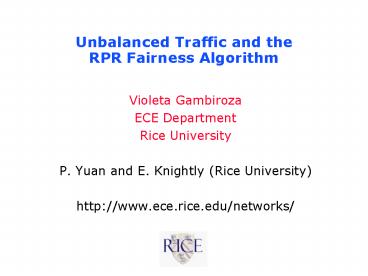Unbalanced Traffic and the RPR Fairness Algorithm - PowerPoint PPT Presentation
1 / 19
Title:
Unbalanced Traffic and the RPR Fairness Algorithm
Description:
Oscillation Conditions Conservative Mode ... (RPR - Conservative Mode) Throughput loss is more than 30% Model matches simulation within 3 ... – PowerPoint PPT presentation
Number of Views:72
Avg rating:3.0/5.0
Title: Unbalanced Traffic and the RPR Fairness Algorithm
1
Unbalanced Traffic and theRPR Fairness Algorithm
- Violeta Gambiroza
- ECE Department
- Rice University
- P. Yuan and E. Knightly (Rice University)
- http//www.ece.rice.edu/networks/
2
Outline
- Unbalanced traffic
- What is it, why should we care?
- Throughput oscillations
- Conditions
- Modeling RPR under unbalanced traffic
- Throughput loss due to oscillations
- Ongoing research
- Impact of TCP
3
Unbalanced Traffic (Unbalanced Traffic with
Unbalanced Inputs)
Unrealistic scenario
4
Upstream Parallel Parking Lot(Unbalanced Traffic
with Balanced Inputs)
Identical, constant rate inputs
5
RPR Oscillations
- Permanent oscillations for many scenarios with
unbalanced traffic - Unbalanced targeted fair rates
6
Oscillation Conditions Aggressive Mode
7
Oscillation Conditions Conservative
Mode(Example)
Flow (1,3) demand 1 Mbps lt C/2 Rate at link 2
after first congestion 622/2 1 (Mbps) lt
low_threshold
8
Oscillation Conditions Conservative Mode
- Proposition 2 For a given fair rate matrix R,
demanded rates r, and congested link j, let na
denote the number of active flows on link j, and
ng denote the number of flows crossing link j
that have both demand and targeted fair rate
greater than C/na. Ignoring low pass filtering
and propagation delay, permanent oscillations
will occur in RPR-CM if there is a flow (n,i)
crossing link j such that the following two
conditions are satisfied
V. Gambiroza, P. Yuan, L. Balzano, Y. Liu, S.
Sheafor, and E. Knightly, Design, Analysis, and
Implementation of DVSR A Fair, High Performance
Protocol for Packet Rings,'' to appear in
IEEE/ACM Transactions on Networking.
where
9
Modeling RPR Oscillations (Analytical and
Simulation Results)
10
Modeling Throughput Loss
- Oscillation results in throughput loss
- Knowing exact rates during one cycle we can write
expression for throughput loss
where N is the number of rate updates in one
cycle
11
Throughput Loss Analytical and Simulation
Results(RPR - Aggressive Mode)
Model matches simulation within 2
Throughput loss as high as 26
12
Throughput Loss Analytical and Simulation
Results(RPR - Conservative Mode)
Model matches simulation within 3
Throughput loss is more than 30
13
Ongoing ResearchImpact of TCP
- Similar oscillations occur with TCP
- Parameters of interest
- Maximum window size - number of packets source is
allowed to send without ACK - STQ size
14
Conclusions
- RPR can permanently oscillate in a wide range
- Root cause is unbalanced traffic (fair rates)
- Throughput loss more than 30 with constant rate
flows - We need to address the problem
- Similar oscillations with TCP flows
- Problem much more complex
- Possible solutions
- Generalize RPR feedback information
- Avoid unbalanced traffic with careful traffic
engineering
15
Future Work
- Modeling RPR
- What other aspects of the RPR-fa can we model?
- Convergence time
- Feedback control with non-FIFO scheduling?
16
Unbalanced Traffic and theRPR Fairness Algorithm
- Violeta Gambiroza
- ECE Department
- Rice University
- P. Yuan and E. Knightly (Rice University)
- http//www.ece.rice.edu/networks/
17
Illustration of Fair Rates (1/3)(Parking Lot)
- 4 flows each receive rate ¼
18
Illustration of Fair Rates (2/3)(Parallel
Parking Lot)
- Each flow receives rate ¼ on downstream link
- Left 1-hop flow fully reclaims excess bandwidth
(¾)
19
Illustration of Fair Rates (3/3) (Upstream
Parallel Parking Lot)
1/4
1/4
1/4
1/4
3/4
- Each flow receives rate ¼ on downstream link
- Left 2-hop flow fully reclaims excess bandwidth
(¾)
- More scenarios Draft v2.0 Annex I.3 Fairness
scenarios - Precise definition http//www.ece.rice.edu/networ
ks/RIAS/


























![[E-BOOK DOWNLOAD] 110 Bite-Sized Super Traffic Tips PowerPoint PPT Presentation](https://s3.amazonaws.com/images.powershow.com/8361643.th0.jpg?_=20160118018)




